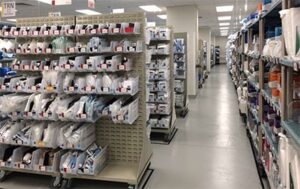
Many hospitals have access to data from their inventory management systems that allow them to analyze usage trends of individual supplies and implants. In the procedural areas of the hospital, where many items can range in price from $500 to $25,000, the cost of having too much inventory on hand can exceed hundreds of thousands of dollars each year. An analysis of the usage data can pinpoint ways to eliminate a large chunk of that waste.
The cost of waste such as overstocked inventory becomes more severe in an economic downturn, like the one the entire world is experiencing due to the global Covid-19 pandemic. Hospitals must conserve their resources to make it through many challenging months and quarters ahead until the negative effects of Covid-19 on the economy begin to abate. Overstocked or unused inventory in the procedural areas of a hospital is typically an easy place to find opportunities to reduce large amounts of waste.
Using data from your inventory management system that allows you to compare actual usage data to on-hand inventory data, you will quickly find many items that appear to be overstocked. However, as easy as it is to identify overstocked inventory, the real challenge arises when proposing these inventory adjustments to physicians. The physicians generating the revenue for the procedural areas typically have a lot of influence when it comes to inventory product mix. When discussing items that are great candidates for elimination, physicians will typically overrule any such changes, saying something along the lines of “we may need that item at some point so we should keep it on hand”. From experience, we have found that presenting data to physicians can be the only way to successfully overcome objections that items are not ready to be eliminated from inventory.
We recommend that inventory managers begin by identifying all items that have not been used in at least a year (and sometimes two or three years!). With this data in hand, it is hard for physicians or business managers to push back, as the data tells the story and the decision becomes less of an emotional one and more a of a data-driven one. While physicians may be able to convince you that some of the items need to be kept on hand, the data should help you get agreement that a good number of the items can be eliminated, especially the items that haven’t been used in years.
We recently had a customer go through this exact same exercise in their Cardiac Cath Labs. They had excess inventories of products that were not being used, but due to old habits were expiring on the shelf and being re-ordered – the very definition of waste. Previous negotiations with physicians about reducing inventory proved challenging because the discussions were held without showing them the data. When these discussions were held with the data provided by the Mobile Aspects Customer Success team, the physicians were more flexible in determining which items truly needed to be kept on hand, and which items could be safely removed from inventory. By the time the process was completed, the inventory manager in the Cardiac Cath Labs was able to methodically reduce 30% of their inventory over a 12-month period.
In order to conserve resources and reduce waste, inventory managers need to play their part by eliminating unnecessary items that can cost hundreds of thousands of dollars per year to keep on hand for no good business reason. Data is the key to this analysis, because without reliable, clean data it will be hard to convince physicians of your findings. If your procedural areas lack the system to provide an easy-to-use data analytics tool, consider a system like iRISupply that marries inventory software with powerful analytics for supplies and implants. This iRISupply will not only provide you with the usage data and reports you need, but will take it one step further and provide actionable recommendations about which products are overstocked, understocked or that can even be eliminated altogether. Mobile Aspects supply chain experts will also sit down with you quarterly as part of a best-in-class customer success program to discuss strategies to optimize your inventory mix and review the data behind those suggestions. These recommendations can then be taken to physicians for review, a discussion that will hopefully lead to substantial savings for your department.
